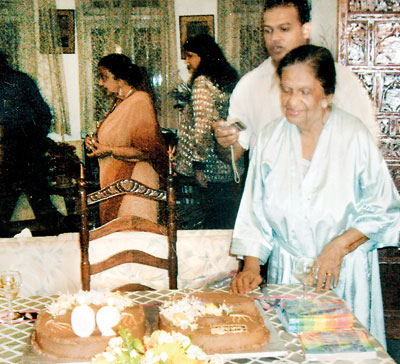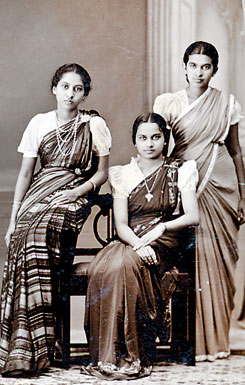Grand old Lady takes us back to that great day in 1948
View(s):By Kumudini Hettiarachchi
Ninety-five and a voracious reader, she sits each day among her beloved books and numerous news clippings.
As Sri Lanka prepares for its 65th Independence Day celebrations in Trincomalee, the time leading up to February 4, 1948 with all the pomp and pageantry is still fresh in her memory.

Celebrating a milestone: Mary Irene Chandraratne cuts her 90th b’day cake
Mary Irene Chandraratne was 30 years old when the country gained independence, she tells the Sunday Times when we meet her at her home off Ward Place on Tuesday.
Smilingly pointing out that her maiden name is Wijeyesekere “with all ‘e’s”, she says at that time her husband, Dr. Modestus Fernando Chandraratne, was an up and coming botanist who would later take over as the Director of Agriculture, a prestigious post, move on to hold the first chair as Professor of Agriculture at the University of Peradeniya and finally travel the world – with her by his side — as an international advisor of the Food and Agriculture Organization.
In her own right too, this mother of four and grandmother of 10 has had her fair share of the limelight. Not only had she been the first-ever Head Girl of Good Shepherd Convent, Kotahena, she had beaten every other girl in the country to become the first in the university entrance examination from the whole island, offering English, Latin and French. “All this was accepted in a spirit of humility,” she says.
It was around 1935 and even at university although co-ed, “there were not so many women”, she had won a scholarship after performing excellently at a special examination. “It was a princely sum of 40 rupees,” she says, adding that due to some procedural changes she only got 20 rupees.
When her husband was serving as a botanist at the Peradeniya Botanical Gardens, Britain’s Southeast Asia Commander during World War II, Lord Louis Mountbatten had his headquarters there, she recalls, wrinkling her brow to remember whether she had met him or just only seen him. As an aside she reminds us that Lady Edwina Mountbatten and then Indian Prime Minister Jawaharlal Nehru had a love affair.
Referring to the time Ceylon gained independence, the elegant saree that Irene wore for the huge party that was held at Queen’s House, she will never forget. “It was a blue saree and I got little forget-me-nots specially embroidered on it,” she says, going down memory lane to an era long gone by.
It was an occasion fit for a Duke and a Duchess, for it was none other than the Duke and Duchess of Gloucester who graced the celebrations when Sri Lanka was freed from the colonial yoke.
The party with all the elegantly-clad guests remains etched in her memory, for it was there Sir Oliver Goonetilleke who would later become Governor General ignored her, pretending that she just did not exist.
Although her husband had faithfully promised to be by her side while coaxing her to go to the party, for she was a shy and diffident young woman having led a sheltered life, “he had disappeared” soon after they arrived at the function. “Sir Oliver passed by, skipping me,” says Irene, giving as the reason for the affront “my father being a nonentity politically”. The families of Sir Oliver and Gilbert, her father, had been neighbours down Castle Street and her father was a close relative of Sir Ernest de Silva. This public figure in fact had been offered the honour of becoming the first local Governor-General but had politely declined.

1939, a picture postcard from the past: Irene (far right) with friends Nanette Ilangakoon and Blossom Asirwadham (centre)
Another “bystander” during the handing over of the governance of then Ceylon to the Ceylonese themselves, who wished to remain anonymous, recalled how a temporary building had been erected at the current site of Independence Square for this momentous event.
“The whole of the ceiling was covered with very colourful streamers,” she says, for she as a 12-year-old had watched wide-eyed on the sidelines the whole august ceremony. They had had a bird’s eye view because at that time a family friend was working at the Department of Government Electrical Undertakings, the building of which overlooked the ceremonial site.
There were also lovely fireworks at Galle Face Green while all the state buildings were floodlit. A vivid memory is of the pictures of prominent leaders in rectangular shapes going up into the sky as fireworks. All those who had cars, sported the flag of Ceylon proudly and people did a walkabout taking in the sights of the lit-up city of Colombo. “Everything was nice, peaceful and orderly. There was no crush,” she says.
For Irene her memories are also replete with how her husband, as a botanist, would be requested by D.S. Senanayake when he was Minister of Agriculture and Lands before independence, to accompany him on circuit. He would be a frequent visitor to the home of the Director of Agriculture at that time, Edmund Rodrigo.
Hearty is the laughter when Irene remembers how D.S. would pile his plate with food and eat everything while breakfasting at the Director’s bungalow and question whether they were hard-up if there were only a few dishes. “He was a real son of the soil,” is her verdict.
Reminiscences about her packed life keep us riveted, but as we bid her goodbye, Irene suddenly picks up the present threads without missing a beat, questioning as to what is happening to the poor while highways and byways are being built.
She shakes her head in dismay over the recent impeachment of the Chief Justice.We leave this Grand Old Lady of Ward Place to her books and newspapers.
Follow @timesonlinelk
comments powered by Disqus

















